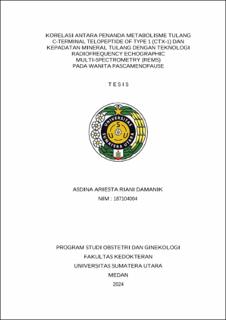| dc.contributor.advisor | Siregar, Muhammad Fidel Ganis | |
| dc.contributor.advisor | Faradina, Dwi | |
| dc.contributor.author | Damanik, Asdina Ariesta Riani | |
| dc.date.accessioned | 2024-09-19T03:37:32Z | |
| dc.date.available | 2024-09-19T03:37:32Z | |
| dc.date.issued | 2024 | |
| dc.identifier.uri | https://repositori.usu.ac.id/handle/123456789/97409 | |
| dc.description.abstract | Background: The sudden decrease in ovarian oestrogen at menopause leads to a rapid decrease in bone density, putting post menopausal women at risk of osteoporosis. One of the bone markers is C-terminal telopeptide of type 1 (CTX-1). The correlation between bone mineral density and bone mineral markers makes bone turnover markers useful in predicting fracture risk, potentially useful in osteoporosis and fracture prevention. Radiofrequency echographic multi-spectrometry (REMS) is a non-ionising technology that evaluates bone status at axial skeletal sites by analysing the original ultrasound signal. Objectives : To evaluate the relationship between C-terminal telopeptide of type 1 and bone mineral density using radiofrequency echographic multi-spectrometry (REMS) technology in postmenopausal women Methods and Materials: This is an analytical observational study with a cross-sectional design. The study was conducted at the Nakita Setia Luhur clinic, Medan and the integrated laboratory of the Faculty of Medicine, Universitas Sumatera Utara. Patients involved were post-menopausal women, aged 45 - 79 years without history of disease or condition that causes early menopause and willing to become research subjects. Results: From 32 subjects, C-terminal telopeptide of type 1 levels in postmenopausal women ranged from 0.17 ng/mL to 0.66 ng/mL which was associated with BMD assessed using radiofrequency echographic multi-spectrometry (REMS) technology ranging from -3.3 to -1. There was a negative correlation with moderate correlation between CTX-1 levels and bone mineral density. CTX-1 can predict osteoporosis with an AUC value of 0.84, sensitivity of 76.9%, specificity of 83.3%%, positive predictive value of 95.2%, negative predictive value of 45.5%, and diagnostic accuracy of 78.1%. Postmenopausal women with CTX-1 levels ≥ 0.28 ng/mL had a 16.667 times greater risk of developing osteoporosis than postmenopausal women with CTX-1 levels < 0.28 ng/mL. Conclusion: Elevated levels of CTX-1 in post-menopausal women will increase the risk of developing osteoporosis. | en_US |
| dc.language.iso | id | en_US |
| dc.publisher | Universitas Sumatera Utara | en_US |
| dc.subject | C-Terminal Telopeptide of Type 1 | en_US |
| dc.subject | Radiofrequency Echographic Multi-Spectrometry | en_US |
| dc.subject | Bone Mineral Density | en_US |
| dc.subject | Post Menopausal Women | en_US |
| dc.subject | SDGs | en_US |
| dc.title | Korelasi antara Penanda Metabolisme Tulang C-Terminal Telopeptide of Type 1 (CTX-1) dan Kepadatan Mineral Tulang dengan Teknologi Radiofrequency Echographic Multi-Spectrometry (REMS) pada Wanita Pascamenopause | en_US |
| dc.title.alternative | Correlation between Bone Metabolism Marker C-Terminal Telopeptide of Type 1 (CTX-1) and Bone Mineral Density using Radiofrequency Echographic Multi-Spectrometry (REMS) Technology in Postmenopausal Women | en_US |
| dc.type | Thesis | en_US |
| dc.identifier.nim | NIM187104004 | |
| dc.identifier.nidn | NIDN0030056407 | |
| dc.identifier.nidn | NIDN0020038004 | |
| dc.identifier.kodeprodi | KODEPRODI11716#Obstetri dan Ginekologi | |
| dc.description.pages | 107 Pages | en_US |
| dc.description.type | Tesis Magister | en_US |


